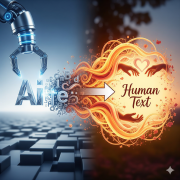One of the key elements of content creation within the modern digital space is artificial intelligence. AI-generated text is often quick and effective, but fails to bring the cosiness and relatability that ordinary readers are interested in. That is where the AI-to-human text converter tools come in. These creative solutions can bridge the distance between the precision of machines and natural communication. They can turn robotic phrases into natural, human-oriented writing and appeal to the audience.
What Is the Difference: AI vs. Human Expression
Even with the fast developments in AI, the output may remain alien or artificial. Among such most frequent rottennesses are:
- Mechanical tone – AI often creates technical and yet emotionless language.
- Stilted structure – Sentences are frequently repetitive and predictable in structure, making them unreadable.
- Absence of subtlety – Minor details like humor, cultural idiom, and empathy are generally absent.
These drawbacks imply that though AI is just fantastic at presenting facts, it cannot narrate a story with the ability to engage human beings.
What an AI Humanizing Tool Does
An AI humanizing tool can overcome them by restructuring and tuning AI output into human communication styles. Specifically, it can:
- Rewrite sentences in a more conversational rhythm.
- Insert typical expressions, analogies, and cultural allusions that render content familiar.
- Create a balance between clarity and emotion whereby the messages should be not only clear but engaging.
In brief, it injects the human flair that AI only outputs generally lacks.
Practical Use Cases
AI humanizing tools are particularly useful in areas where the precision of technical description and storytelling imagination are needed. Practical applications using the methodology include:
 Technology explainers – Compound topics can be transformed into appealing stories that are easy to understand to read and listen to.
Technology explainers – Compound topics can be transformed into appealing stories that are easy to understand to read and listen to.- Fiction or speculative essays – Imaginative richness and stylistic flair may be introduced to fit the imaginative themes the reader anticipates.
- Blog introductions and conclusions – Rather than generic and stiff AI-generated openings, humanizing tools assist in writing catchy introductions and interesting conclusions.
To offer readers an idea of how to incorporate technology into the storyline, the article “Growing Your YouTube Channel Authentically with Smart Engagement Strategies“ explains how technology can be used to help define the tone, depth, and relatability of a futuristic narrative. Using the identical strategy with an AI humanizing tool, authors should be able to maintain their authenticty, and at the same time, develop real engagement with the audience.
Why Humanizing is Important in Sci-Fi
It is not only about facts and futuristic speculations but people, their hopes and fears, and dreams. This emotional aspect is commonly lacking in AI-written texts. Humanization of text allows content creators to include the emotion and creativity that sci-fi audiences need so that the story and essay not only inform but also captivate.
Final Thoughts
The AI humanizing tools are a combination of efficiency and effectiveness of automation, and the human touch of expressing their emotions. They offer a way to introduce daring, futuristic concepts in a manner that resonates with the readers. These tools are used to make sure that even the most technical topics are not only comprehended but also experienced by blending visionary with relatable language.

 Technology explainers – Compound topics can be transformed into appealing stories that are easy to understand to read and listen to.
Technology explainers – Compound topics can be transformed into appealing stories that are easy to understand to read and listen to.